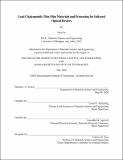| dc.contributor.advisor | Lionel C. Kimerling and Anuradha M. Agarwal. | en_US |
| dc.contributor.author | Su, Peter,Ph.D.(Peter Xinyang)Massachusetts Institute of Technology. | en_US |
| dc.contributor.other | Massachusetts Institute of Technology. Department of Materials Science and Engineering. | en_US |
| dc.date.accessioned | 2020-11-23T17:39:58Z | |
| dc.date.available | 2020-11-23T17:39:58Z | |
| dc.date.copyright | 2020 | en_US |
| dc.date.issued | 2020 | en_US |
| dc.identifier.uri | https://hdl.handle.net/1721.1/128583 | |
| dc.description | Thesis: Ph. D., Massachusetts Institute of Technology, Department of Materials Science and Engineering, May, 2020 | en_US |
| dc.description | Cataloged from the official PDF of thesis. | en_US |
| dc.description | Includes bibliographical references (pages 117-130). | en_US |
| dc.description.abstract | Lead chalcogenides are compounds of lead and a combination of the chalcogens sulfur, selenium, and tellurium. They are semiconductors with band gap energies in the infrared region of the electromagnetic spectrum, making them interesting infrared detector materials for both free space and photonic integrated circuit applications. For longer wavelengths of infrared light, they are transparent dielectric materials with extremely large refractive indices, making them potentially interesting materials for free space dielectric metasurfaces. In this work, we study both the processing, properties, and performance of lead chalcogenide materials as thin films and their integration and use in specific infrared photonic devices. | en_US |
| dc.description.abstract | For materials development, we examine how we can use and improve lead chalcogenide thin films for infrared detector applications, both through tuning their band gaps via alloying of the binary lead chalcogenide compounds (PbS, PbSe, PbTe), where we show photoconductivity of ternary alloys greater than an order of magnitude above their noise level; and through controlling their majority carrier type and concentration via the addition of PbO to the thin film deposition source material, which can then be utilized to deposit detectors with 2-3 times higher responsivity. For device applications, we integrated PbTe detectors into photonic integrated circuit methane sensors and developed a new patterning method for PbTe thin films for use as transmissive dielectric metasurfaces. | en_US |
| dc.description.abstract | Integrating PbTe detectors into the photonic integrated circuit improved the methane sensing performance by 2.5 times, while a ratiometric architecture we designed and tested with an electronic read out circuit tuned to the properties of the integrated PbTe detector promise both the elimination of input laser power fluctuations as a source of spurious signals and 5 times better sensor performance with our testing equipment. Modulating the laser input at even higher frequencies promises even better performance, with an anticipated limit of detection of 0.11 vol% of methane [square root]H[subscript z]. For patterning transmissive dielectric metasurfaces, a new fabrication method using nanostencils was designed and tested, creating PbTe metalenses with diffraction limited performance and efficiencies of 40+%. | en_US |
| dc.description.statementofresponsibility | by Peter Su. | en_US |
| dc.format.extent | 130 pages | en_US |
| dc.language.iso | eng | en_US |
| dc.publisher | Massachusetts Institute of Technology | en_US |
| dc.rights | MIT theses may be protected by copyright. Please reuse MIT thesis content according to the MIT Libraries Permissions Policy, which is available through the URL provided. | en_US |
| dc.rights.uri | http://dspace.mit.edu/handle/1721.1/7582 | en_US |
| dc.subject | Materials Science and Engineering. | en_US |
| dc.title | Lead chalcogenide thin film materials and processing for infrared optical devices | en_US |
| dc.type | Thesis | en_US |
| dc.description.degree | Ph. D. | en_US |
| dc.contributor.department | Massachusetts Institute of Technology. Department of Materials Science and Engineering | en_US |
| dc.identifier.oclc | 1200754044 | en_US |
| dc.description.collection | Ph.D. Massachusetts Institute of Technology, Department of Materials Science and Engineering | en_US |
| dspace.imported | 2020-11-23T17:39:56Z | en_US |
| mit.thesis.degree | Doctoral | en_US |
| mit.thesis.department | MatSci | en_US |
